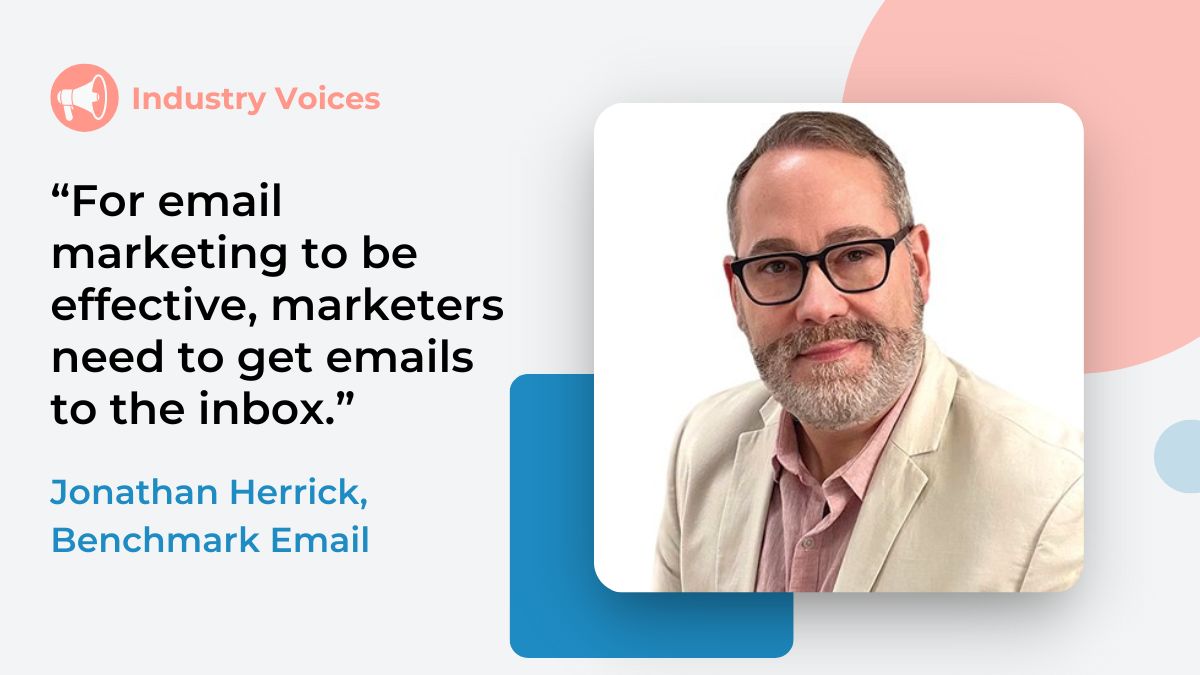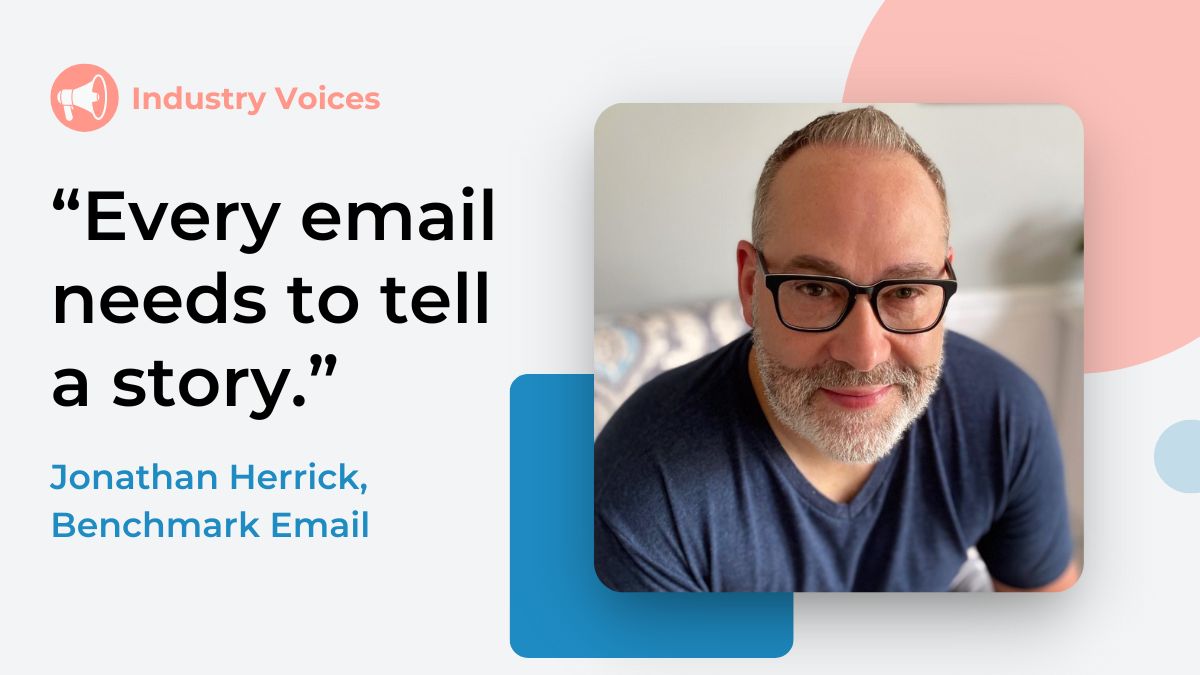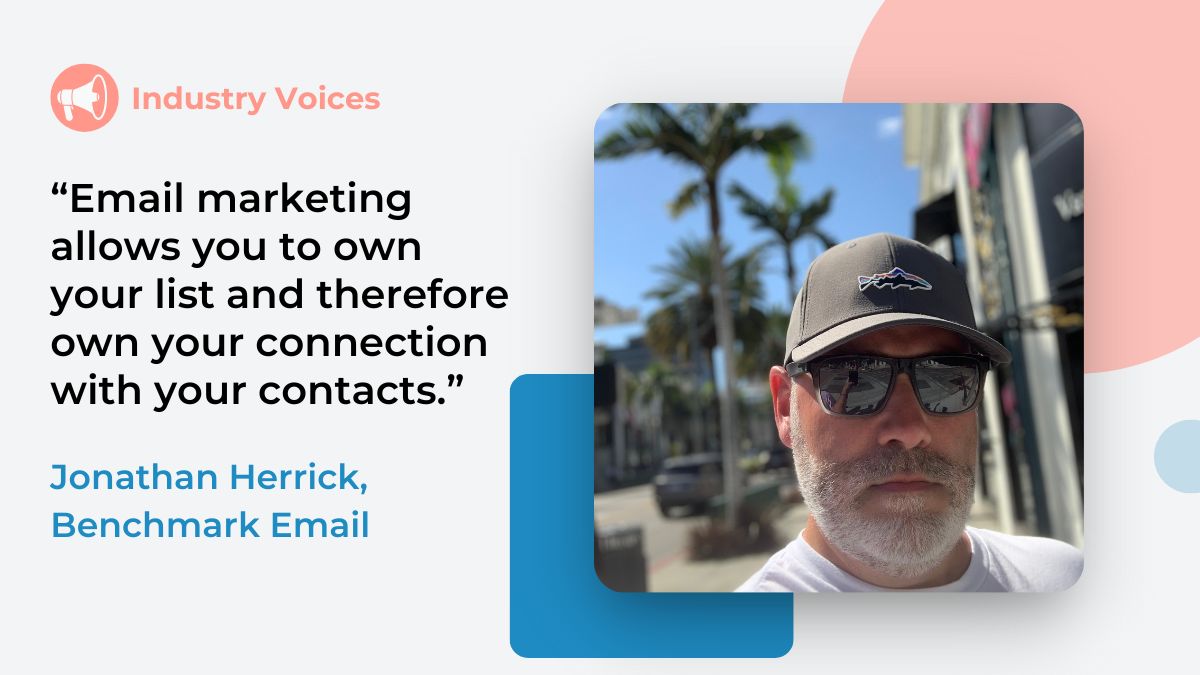
Jonathan Herrick, Benchmark Email: On AI Tools for Email Marketing and 3 Steps to Boost Email ROI
Benchmark Email CEO Jonathan Herrick talks about how his team uses AI tools to make email marketing painless for their customers. The email pro also addresses the power of storytelling and other strategies that work for email marketers.
Jonathan Herrick started out as a customer of Benchmark Email and ended up as CEO. With offices around the world, the company helps small and medium-sized businesses (SMBs) simplify their marketing – and get better results.
In this interview, Herrick talks to ZeroBounce about:
- AI tools and how Benchmark Email uses them to make email writing quick and easy
- The biggest mistakes that can get emails reported as spam and directed to the spam folder
- A habit he notices in people who succeed.
Jonathan Herrick also shares three simple things you can do today to improve your email marketing results.
Read on to see what else this man from the Show Me State can show us.
Tell us about yourself, Jonathan! Our readers would love to learn about you and what makes you tick.
I am the CEO of Benchmark Email, and I am blessed to be a part of an amazing team. We have a deep passion for helping SMBs simplify their marketing so they can build better relationships and grow their business. Every day I wake up excited to find ways to better solve our customers’ challenges and to deliver a better experience.
One of the things I love most about Benchmark is our culture. We have offices around the globe, so I get the chance to watch our diverse team members interact with each other to drive innovation for our company and our customers.
When I am not leading the charge at Benchmark, you can find me spending my time with my amazing family and my dog Finnley.
You’ve had a chance to witness many of the “ins and outs” of the email industry. So what do you see that works for email marketers?
Having tools that are simple and easy to use is essential and will always have staying power within the industry, no matter what ups and downs occur.
Marketers and small business owners are so busy. They’re often playing more roles within their company than one, so using a tool with tons of features that take a while to master isn’t helpful or effective for their process.
Email marketing has been around for a while, and while new developments within the industry are always exciting, it doesn’t mean that the tools you’re using need to get more complicated.
For email marketing to be effective, marketers need to get emails to the inbox. Keeping your process simple with a tool that is intuitive and does the heavy lifting for you can make all the difference in delivering more emails with less work.

Where do you see email marketers go wrong? What are some common missteps or blunders?
A lot of email marketers are doing things that negatively impact their deliverability without really knowing it.
Some email marketers are using practices that are considered spammy, like using certain words or design tactics that make their emails look less than legit, motivating recipients to mark them as spam and never look back.
Also, email marketers need to routinely examine their lists for inactive or unengaged accounts. Continuing to send emails to inactive or incorrect email addresses will increase your bounce rate over time and eat away at a sender’s deliverability.
RELATED: Learn the difference between soft and hard bounces
This isn’t a quick fix, though. It can take hours to manually sift through email addresses to identify any incorrect spelling and track down email accounts that aren’t opening or responding to your emails.
That’s why we created our Smart Sending feature, which identifies these unengaged accounts for our users and instead targets the most engaged recipients for improved deliverability.
How has the mission of Benchmark Email changed as the email space has evolved?
Our mission to make email marketing simple for SMBs hasn’t changed. In fact, it’s this focus that has helped guide us as the space has evolved. We’re always focused on how anyone wearing the email marketing hat can quickly send emails and get results. That way, they can focus on the most important activities in their day.
Introducing generative AI, Smart Content in the app, and leveraging machine learning to increase engagement are just two ways we’re making email marketing simpler and more effective for our users.
How important is storytelling in email marketing?
It’s incredibly important! Every email needs to tell a story. Now, I’m not saying each email you send needs to be a novel (the opposite, in fact). But each message should have a beginning, middle and end.
Telling a story is the best way to engage your audience. You need to lock them in by telling them why they’re here and reading your email. Then you need to present the offer, which serves as the climax, and end with a CTA.
It’s your job to guide the email recipient through the email you’re sending so they’ll take action. Using basic storytelling techniques is a great way to accomplish that.
RELATED: How to Use the AIDA Model to Write Better Emails and Generate Revenue

The world has two letters circling around in their head: “A.I.” How does Benchmark use AI tools?
From a content creation standpoint, we love using AI tools. A lot of people think that AI does the heavy lifting for you. While that is somewhat true, it’s still up to the user to be creative with prompts for compelling and engaging outcomes.
Our marketing team regularly uses AI content-generating tools, like ChatGPT, to think of content ideas that push our strategy forward and provide our blog readers with education beyond your basic email marketing-related topics. AI content-generating tools are also great for assembling data quickly and help us assemble content that we can later refine, tweak and optimize.
When it comes to email marketing, we saw a huge opportunity for harnessing the power of AI. Our users are busy, often doing numerous jobs at the same time. Creating email content was just another roadblock, and overcoming the anxiety of a blank page can be pretty intimidating.
So, in partnership with OpenAI, the research firm behind ChatGPT, we created our Smart Content feature in Benchmark Email. Smart Content brings the power of AI-generated content into the email marketing process, assisting users with creating fresh, engaging email content that will delight their subscribers. Now, our users can put together emails faster and easier than ever before; no content brainstorming is required.
What’s the biggest reason people perceive a legitimate email as being “spam”?
People’s inboxes are busy. So if a brand they newly subscribed to is adding to that clutter, they’ll quickly mark it as spam and move on.
It’s important for marketers to email their subscribers so they can stay top of mind. But if they’re not adding value, it’s a great way to be marked as spam. For example, if the user is expecting a valuable resource from a download but receives a thinly-veiled sales email, their expectations aren’t being met, and they’ll mark it as spam.
Another example is if a user signs up for a monthly newsletter but gets emailed daily with offers they aren’t interested in. They’ll likely mark as spam.
It also can come down to the email subject line, as that is the first thing people see before opening an email. If the sender uses a lot of caps or spam trigger words like “Bargain” or “Risk-Free”, it’s a quick trip to the spam folder.
What are the most common reasons you see that cause emails to go to the spam folder?
Content.
If you’re failing to send your subscribers content that resonates with them, they’ll see your emails as useless and spammy. It comes down to making sure you understand your subscribers’ needs and pain points so you can cater your email content to them. Pair that with a consistent and informed content-creation strategy, and you’ll be able to reach and engage your audience and avoid the spam folder.
RELATED: Why emails go to spam – and how to fix it
Another big one is low list quality. Low list quality often happens with purchased lists, as you don’t know who is actually on the list and if they even want to hear from you. The same goes for emailing contacts who have not opted into your email marketing.
When you repeatedly email people who haven’t expressed interest in hearing from you, not only is that just bad email marketing practice, but it is a great way to be marked as spam.
Jonathan, what makes you really connect with a particular email list you subscribe to?
Personalization. If I decide to sign up for a particular brand’s email marketing and they fail to send me emails that cater to my exact needs, then I won’t be a subscriber for long.
Everyone wants to find what they need, but in an easier, more straightforward way. When brands are able to anticipate the needs of their subscribers by sending them personalized offers, content and information, then those subscribers will stick around, simple as that.
Give us one three things anyone can do today to improve their email marketing results.
#1. Segment your email list. The first step to personalization is segmentation. So if you’re sending the same content to everyone, you’re missing an opportunity. There are a ton of ways you can break down your list to make your emails more personal. If you’re not segmenting your list today, I’d challenge you to create one or two segments and see a lift in your results.
#2. Clean your email list. This is really just a housekeeping item, but it’s important for email deliverability. The size of your list doesn’t matter if no one is engaging, so don’t be afraid to sideline unengaged and invalid contacts. The pay-off is more engagement with contacts who are going to convert.
#3. Automate one thing. Email automation can sound technical and overwhelming if you haven’t used automation yet. But anyone can work more efficiently and get better results with automation. So I challenge you to create your first email automation, or if you’re already using automation, automate one more process.
RELATED: 6 email automation mistakes to watch out for
It can be as easy as adding an autoresponder email to a subscriber form or creating a simple three-step email campaign. With automation, you’re increasing engagement in an intelligent way without adding a manual process to someone’s plate. It’s a win-win.
What is email’s greatest power for businesses?
Connection.
Email is a direct line to your consumer (or potential consumer). No other marketing strategy can give you that kind of connection with your audience, and it’s incredibly effective. Email marketing allows you to own your list and therefore own your connection with your contacts. Social platforms may give you an audience, but that audience can disappear at any time.
There is a reason why email marketing has the highest ROI of any other marketing approach out there. It’s because when you are able to directly connect with your audience and send them personalized outreach that addresses their needs, you build trust and connection that translates into a partnership.

Quick question, quick answer with Jonathan Herrick
Is there a most entertaining social media platform?
It might sound crazy because I have been in the tech world for so long, but to be honest, I try not to spend too much time on social media. I would rather spend that time building into my team or my family.
What is the best way to get new email subscribers?
Creating value for your audience and by placing opt-in, GDPR-compliant email forms on your website and landing pages.
Favorite breakfast food?
My go-to is a protein smoothie and an extra dark chocolate and sea salt Kind bar.
What is your favorite place to get work done?
I work from home, so I would have to say my favorite place to work is on the outside deck at my house, especially in the springtime and early fall, with my dog Finnely by my side.
A brand email you always open?
Consumer-wise, I would have to say Amazon since we always seem to have something delivered to the house.
On the business side, I always open emails from SaaStr as their content is on point and always provides great insights.
The cringiest thing an email marketer could do?
Spam email subscribers or inundate them with emails that are too salesy or pushy and don’t offer any true value.
A brand you feel knocks email marketing out of the park?
I really admire what Litmus does. I routinely look forward to their emails because their copy does a great job of pulling you in and making you interested in the content they’re sharing.
If you could email anyone in the world, who would it be? What would you ask that person?
I would email Tim Cook, CEO of Apple, and ask for a lunch meeting to discuss the inner workings of the innovation engine that powers Apple.
Another leader I would send an email to is Mary Barra, CEO of General Motors. She is the first woman to lead as a CEO in the US auto industry, and I would love to have a conversation with her about her vision for the GM brand and how the company has created a culture of innovation. I would also ask her what are the key initiatives to create more diversity and equality in the workforce so that we can open up opportunities for our next generation of leaders.
What website do you go to the most?
Google and Amazon Quicksight, which powers our internal reporting.
What habit do you see in people who succeed?
A habit that I see most often in those who succeed is the inability to be complacent. The most successful people in my life are those that are never satisfied and try to constantly look for new solutions or ways to innovate and achieve their goals.
Table of Contents
- Tell us about yourself, Jonathan! Our readers would love to learn about you and what makes you tick.
- You’ve had a chance to witness many of the “ins and outs” of the email industry. So what do you see that works for email marketers?
- Where do you see email marketers go wrong? What are some common missteps or blunders?
- How has the mission of Benchmark Email changed as the email space has evolved?
- How important is storytelling in email marketing?
- The world has two letters circling around in their head: “A.I.” How does Benchmark use AI tools?
- What’s the biggest reason people perceive a legitimate email as being “spam”?
- What are the most common reasons you see that cause emails to go to the spam folder?
- Jonathan, what makes you really connect with a particular email list you subscribe to?
- Give us one three things anyone can do today to improve their email marketing results.
- What is email’s greatest power for businesses?
- Quick question, quick answer with Jonathan Herrick
- Is there a most entertaining social media platform?
- What is the best way to get new email subscribers?
- Favorite breakfast food?
- What is your favorite place to get work done?
- A brand email you always open?
- The cringiest thing an email marketer could do?
- A brand you feel knocks email marketing out of the park?
- If you could email anyone in the world, who would it be? What would you ask that person?
- What website do you go to the most?
- What habit do you see in people who succeed?






